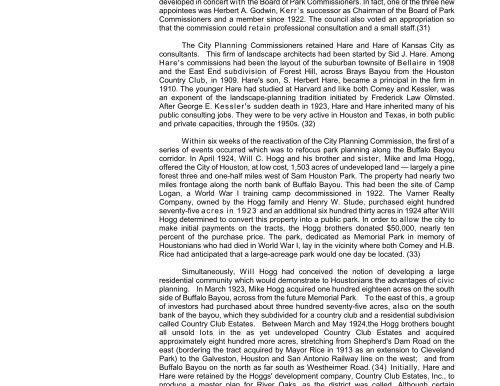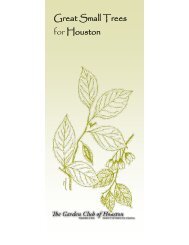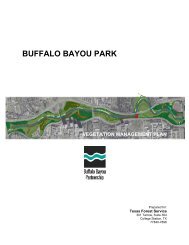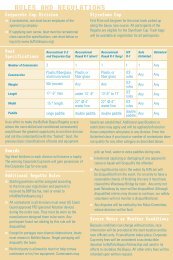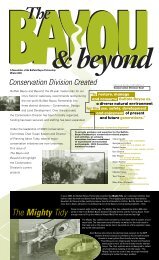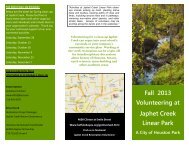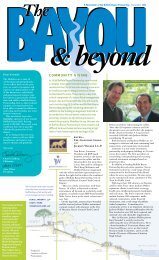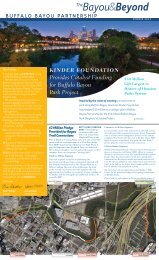History of the Shepherd to Sabine project area - Buffalo Bayou Park
History of the Shepherd to Sabine project area - Buffalo Bayou Park
History of the Shepherd to Sabine project area - Buffalo Bayou Park
You also want an ePaper? Increase the reach of your titles
YUMPU automatically turns print PDFs into web optimized ePapers that Google loves.
developed in concert with <strong>the</strong> Board <strong>of</strong> <strong>Park</strong> Commissioners. In fact, one <strong>of</strong> <strong>the</strong> three newappointees was Herbert A. Godwin, Kerr’s successor as Chairman <strong>of</strong> <strong>the</strong> Board <strong>of</strong> <strong>Park</strong>Commissioners and a member since 1922. The council also voted an appropriation sothat <strong>the</strong> commission could retain pr<strong>of</strong>essional consultation and a small staff.(31)The City Planning Commissioners retained Hare and Hare <strong>of</strong> Kansas City asconsultants. This firm <strong>of</strong> landscape architects had been started by Sid J. Hare. AmongHare's commissions had been <strong>the</strong> layout <strong>of</strong> <strong>the</strong> suburban <strong>to</strong>wnsite <strong>of</strong> Bellaire in 1908and <strong>the</strong> East End subdivision <strong>of</strong> Forest Hill, across Brays <strong>Bayou</strong> from <strong>the</strong> Hous<strong>to</strong>nCountry Club, in 1909. Hare's son, S. Herbert Hare, became a principal in <strong>the</strong> firm in1910. The younger Hare had studied at Harvard and like both Comey and Kessler, wasan exponent <strong>of</strong> <strong>the</strong> landscape-planning tradition initiated by Frederick Law Olmsted.After George E. Kessler's sudden death in 1923, Hare and Hare inherited many <strong>of</strong> hispublic consulting jobs. They were <strong>to</strong> be very active in Hous<strong>to</strong>n and Texas, in both publicand private capacities, through <strong>the</strong> 1950s. (32)Within six weeks <strong>of</strong> <strong>the</strong> reactivation <strong>of</strong> <strong>the</strong> City Planning Commission, <strong>the</strong> first <strong>of</strong> aseries <strong>of</strong> events occurred which was <strong>to</strong> refocus park planning along <strong>the</strong> <strong>Buffalo</strong> <strong>Bayou</strong>corridor. In April 1924, Will C. Hogg and his bro<strong>the</strong>r and sister, Mike and Ima Hogg,<strong>of</strong>fered <strong>the</strong> City <strong>of</strong> Hous<strong>to</strong>n, at low cost, 1,503 acres <strong>of</strong> undeveloped land — largely a pineforest three and one-half miles west <strong>of</strong> Sam Hous<strong>to</strong>n <strong>Park</strong>. The property had nearly twomiles frontage along <strong>the</strong> north bank <strong>of</strong> <strong>Buffalo</strong> <strong>Bayou</strong>. This had been <strong>the</strong> site <strong>of</strong> CampLogan, a World War I training camp decommissioned in 1922. The Varner RealtyCompany, owned by <strong>the</strong> Hogg family and Henry W. Stude, purchased eight hundredseventy-five acres in 1923 and an additional six hundred thirty acres in 1924 after WillHogg determined <strong>to</strong> convert this property in<strong>to</strong> a public park. In order <strong>to</strong> allow <strong>the</strong> city <strong>to</strong>make initial payments on <strong>the</strong> tracts, <strong>the</strong> Hogg bro<strong>the</strong>rs donated $50,000, nearly tenpercent <strong>of</strong> <strong>the</strong> purchase price. The park, dedicated as Memorial <strong>Park</strong> in memory <strong>of</strong>Hous<strong>to</strong>nians who had died in World War I, lay in <strong>the</strong> vicinity where both Comey and H.B.Rice had anticipated that a large-acreage park would one day be located. (33)Simultaneously, Will Hogg had conceived <strong>the</strong> notion <strong>of</strong> developing a largeresidential community which would demonstrate <strong>to</strong> Hous<strong>to</strong>nians <strong>the</strong> advantages <strong>of</strong> civicplanning. In March 1923, Mike Hogg acquired one hundred eighteen acres on <strong>the</strong> southside <strong>of</strong> <strong>Buffalo</strong> <strong>Bayou</strong>, across from <strong>the</strong> future Memorial <strong>Park</strong>. To <strong>the</strong> east <strong>of</strong> this, a group<strong>of</strong> inves<strong>to</strong>rs had purchased about three hundred seventy-five acres, also on <strong>the</strong> southbank <strong>of</strong> <strong>the</strong> bayou, which <strong>the</strong>y subdivided for a country club and a residential subdivisioncalled Country Club Estates. Between March and May 1924,<strong>the</strong> Hogg bro<strong>the</strong>rs boughtall unsold lots in <strong>the</strong> as yet undeveloped Country Club Estates and acquiredapproximately eight hundred more acres, stretching from <strong>Shepherd</strong>'s Dam Road on <strong>the</strong>east (bordering <strong>the</strong> tract acquired by Mayor Rice in 1913 as an extension <strong>to</strong> Cleveland<strong>Park</strong>) <strong>to</strong> <strong>the</strong> Galves<strong>to</strong>n, Hous<strong>to</strong>n and San An<strong>to</strong>nio Railway line on <strong>the</strong> west; and from<strong>Buffalo</strong> <strong>Bayou</strong> on <strong>the</strong> north as far south as Wes<strong>the</strong>imer Road. (34) Initially, Hare andHare were retained by <strong>the</strong> Hoggs' development company, Country Club Estates, Inc., <strong>to</strong>


